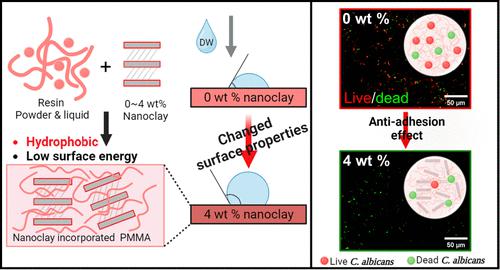当前位置:
X-MOL 学术
›
ACS Biomater. Sci. Eng.
›
论文详情
Our official English website, www.x-mol.net, welcomes your feedback! (Note: you will need to create a separate account there.)
Mechanophysical and Anti-Adhesive Properties of a Nanoclay-Containing PMMA Denture Resin
ACS Biomaterials Science & Engineering ( IF 5.8 ) Pub Date : 2024-03-07 , DOI: 10.1021/acsbiomaterials.3c01817 Jun-Yong Ahn 1 , Yu-Jin Kim 1, 2 , Jung-Hwan Lee 1, 2, 3 , Rajendra K. Singh 2, 3 , Hae-Hyoung Lee 1, 2, 3
ACS Biomaterials Science & Engineering ( IF 5.8 ) Pub Date : 2024-03-07 , DOI: 10.1021/acsbiomaterials.3c01817 Jun-Yong Ahn 1 , Yu-Jin Kim 1, 2 , Jung-Hwan Lee 1, 2, 3 , Rajendra K. Singh 2, 3 , Hae-Hyoung Lee 1, 2, 3
Affiliation

|
Poly(methyl methacrylate) (PMMA) is commonly used for dental dentures, but it has the drawback of promoting oral health risks due to oral bacterial adhesion. Recently, various nanoparticles have been incorporated into PMMA to tackle these issues. This study aims to investigate the mechanophysical and antimicrobial adhesive properties of a denture resin by incorporating of nanoclay into PMMA. Specimens were prepared by adding 0, 1, 2, and 4 wt % surface-modified nanoclay (Sigma) to self-polymerizing PMMA denture resin. These specimens were then evaluated using FTIR, TGA/DTG, and FE-SEM with EDS. Various mechanical and surface physical properties, including nanoindentation, were measured and compared with those of pure PMMA. Antiadhesion experiments were conducted by applying a Candida albicans (ATCC 11006) suspension to the surface of the specimens. The antiadhesion activity of C. albicans was confirmed through a yeast-wall component (mannan) and mRNA-seq analysis. The bulk mechanical properties of nanoclay-PMMA composites were decreased compared to those of pure PMMA, while the flexural strength and modulus met the ISO 20795–1 requirement. However, there were no significant differences in the nanoindentation hardness and elastic modulus. The surface energy revealed a significant decrease at 4 wt % nanoclay-PMMA. The antiadhesion effect of Candida albicans was evident along with nanoclay content in the nanocomposites and confirmed by the reduced attachment of mannan on nanoclay-PMMA composites. mRNA-seq analysis supported overall transcriptome changes in altering attachment and metabolism behaviors on the surface. The nanoclay-PMMA materials showed a lower surface energy as the content increased, leading to an antiadhesion effect against Candida albicans. These findings indicate that incorporating nanoclay into PMMA surfaces could be a valuable strategy for preventing the fungal biofilm formation of denture base materials.
中文翻译:

含纳米粘土 PMMA 义齿树脂的机械物理和抗粘连性能
聚甲基丙烯酸甲酯(PMMA)通常用于假牙,但它的缺点是由于口腔细菌粘附而增加口腔健康风险。最近,各种纳米颗粒已被纳入 PMMA 中来解决这些问题。本研究旨在通过将纳米粘土掺入 PMMA 来研究义齿树脂的机械物理和抗菌粘合性能。通过向自聚合 PMMA 义齿树脂中添加 0、1、2 和 4 wt% 表面改性纳米粘土 (Sigma) 来制备样本。然后使用 FTIR、TGA/DTG 和 FE-SEM 结合 EDS 对这些样本进行评估。测量了各种机械和表面物理性能,包括纳米压痕,并与纯 PMMA 进行了比较。通过将白色念珠菌(ATCC 11006) 悬浮液涂在样本表面来进行抗粘连实验。通过酵母壁成分(甘露聚糖)和 mRNA-seq 分析证实了白色念珠菌的抗粘附活性。与纯PMMA相比,纳米粘土-PMMA复合材料的整体机械性能有所下降,而弯曲强度和模量满足ISO 20795-1要求。然而,纳米压痕硬度和弹性模量没有显着差异。纳米粘土-PMMA 含量为 4 wt% 时,表面能显着降低。白色念珠菌的抗粘附作用随着纳米复合材料中纳米粘土含量的增加而明显,并且通过甘露聚糖在纳米粘土-PMMA复合材料上的附着减少得到证实。 mRNA-seq 分析支持改变表面附着和代谢行为的整体转录组变化。随着含量的增加,纳米粘土-PMMA材料表现出较低的表面能,从而对白色念珠菌具有抗粘附作用。这些发现表明,将纳米粘土掺入 PMMA 表面可能是防止义齿基托材料形成真菌生物膜的有效策略。
更新日期:2024-03-07
中文翻译:

含纳米粘土 PMMA 义齿树脂的机械物理和抗粘连性能
聚甲基丙烯酸甲酯(PMMA)通常用于假牙,但它的缺点是由于口腔细菌粘附而增加口腔健康风险。最近,各种纳米颗粒已被纳入 PMMA 中来解决这些问题。本研究旨在通过将纳米粘土掺入 PMMA 来研究义齿树脂的机械物理和抗菌粘合性能。通过向自聚合 PMMA 义齿树脂中添加 0、1、2 和 4 wt% 表面改性纳米粘土 (Sigma) 来制备样本。然后使用 FTIR、TGA/DTG 和 FE-SEM 结合 EDS 对这些样本进行评估。测量了各种机械和表面物理性能,包括纳米压痕,并与纯 PMMA 进行了比较。通过将白色念珠菌(ATCC 11006) 悬浮液涂在样本表面来进行抗粘连实验。通过酵母壁成分(甘露聚糖)和 mRNA-seq 分析证实了白色念珠菌的抗粘附活性。与纯PMMA相比,纳米粘土-PMMA复合材料的整体机械性能有所下降,而弯曲强度和模量满足ISO 20795-1要求。然而,纳米压痕硬度和弹性模量没有显着差异。纳米粘土-PMMA 含量为 4 wt% 时,表面能显着降低。白色念珠菌的抗粘附作用随着纳米复合材料中纳米粘土含量的增加而明显,并且通过甘露聚糖在纳米粘土-PMMA复合材料上的附着减少得到证实。 mRNA-seq 分析支持改变表面附着和代谢行为的整体转录组变化。随着含量的增加,纳米粘土-PMMA材料表现出较低的表面能,从而对白色念珠菌具有抗粘附作用。这些发现表明,将纳米粘土掺入 PMMA 表面可能是防止义齿基托材料形成真菌生物膜的有效策略。



























 京公网安备 11010802027423号
京公网安备 11010802027423号